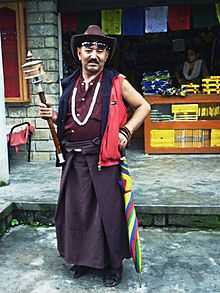Rewalsar Lake
| Rewalsar Lake | |
|---|---|
 | |
| Location | Mandi district |
| Coordinates | 31°38′02″N 76°50′00″E / 31.63389°N 76.83333°ECoordinates: 31°38′02″N 76°50′00″E / 31.63389°N 76.83333°E |
| Type | Mid altitude lake |
| Basin countries | India |
| Shore length1 | 735 m |
| Surface elevation | 1,360 m |
| References | Himachal Pradesh Tourism Dept. |
| 1 Shore length is not a well-defined measure. | |



Rewalsar Lake, or Tso Pema Lotus Lake, is a mid-altitude lake located on a mountain spur in Mandi district, 22.5 km south-west from Mandi. Its elevation is about 1,360 m above sea level.
The lake is shaped like a square with the shoreline of about 735 m. It is held as a sacred spot for Hindus, Sikhs and Buddhists alike. With water, woodland and high hills, it presents a variety of natural beauty.[1]
There are three Buddhist monasteries at Rewalsar. The lake also has three Hindu temples dedicated to Lord Krishna, Lord Shiva and to the sage Lomas. Another holy lake, Kunt Bhyog which is about 1,750 m above sea level lies above Rewalsar.[2] It is associated with the escape of 'Pandavas' from the burning palace of wax—an episode from the epic Mahabharata.
It was from here that the great Indian teacher and `Tantric` Padmasambhava left for Tibet. Known to the Tibetans as 'Guru Rinpoche', the Precious Master, it was under Padmasambhava's influence that Mahayana Buddhism spread over Tibet. There are islands of floating reed on Rewalsar lake and the spirit of Padmasambhava is said to reside in them. It is here that the sage Lomas did penance in devotion to Lord Shiva, and the Sikh guru Gobind Singh (22 December 1666 – 7 October 1708), the tenth Guru of Sikhism, also resided here for one month.
The Sisu fair held in late February/early march, and the festival of Baisakhi are important events at Rewalsar.
The legend of Padmasambhava and Princess Mandarava of Mandi (Zahor)
Mandarava and Padmasambhava were energetically drawn to one another. Vihardhara, fearful of the contamination of the royal bloodline and what he perceived as Mandarava's apostasy, endeavoured to have Mandarava and Padmasambhava purified by immolation through the flames of a pyre. Instead of finding their corpses incensed and charred, Vihardhara finds that the fire of the pyre has been transformed into Lake Rewalsar, out of which arises a blooming lotus that supports the unharmed Mandarava and Padmasambhava who through this manifestation of their realisation have achieved their secret names of Vajravarahi and Hayagriva, respectively, after which Vihardhara furnishes the union with his unreserved blessings.
Legend has it that the great teacher Padmasambhava (Guru Rinpoche) used his enormous power to take flight to Tibet from Rewalsar. In Rewalsar, his spirit is said to reside in the tiny island of floating reed that drifts over the water.

Footnotes
- ↑ Emerson (1920), p. 203.
- ↑ himachaltourism.gov.in
References
- Emerson (1920). Gazetteer of the Mandi State 1920. Reprint: 1996. Indus Publishing House, Delhi. ISBN 81-7387-054-3.
- Singh, Sarina (2009). India (Lonely Planet Country Guide) (Paperback). 13th Updated edition. ISBN 978-1-74179-151-8.
External links
| ||||||||||||||||||||||